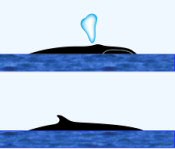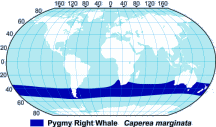Pygmy Right Whale
CLASS: Mammalia
ORDER: Cetacea
SUBORDER: Mysticeti
FAMILY: Balaenidae
GENUS: Caperea
SPECIES: marginata
The pygmy right whale, rarely seen at sea, is the smallest and most mysterious of the baleen whales. Information about this whale is sketchy at best, since only a few dozen stranded specimens have been examined by scientists. Many reported sightings have probably been incorrectly identified minke whales; the small size, dark color, and curved dorsal fin make it almost impossible to tell the two species apart when they are seen at the water's surface.
Physical Description
Although the pygmy right whale is classified with the other right whales (northern and southern right whales and the bowheads), the only feature that all these species have in common is the shape of the mouth. Its upper jaw is arched while the lower jaw is bowed - a feature that seems to become more pronounced with age. Its lower jaw extends slightly beyond the upper jaw. Two indistinct grooves are situated lengthwise in the area of the throat which are similar to the throat grooves of the gray whale. This whale has a small head which takes up only 1/4 its total body length. The blow is small and not very noticeable. There are 210-230 baleen plates on each side of the pygmy right whale's upper jaw. These plates are yellowish-white with a dark brown marginal band on the edge. The baleen plates are up to 27 inches long (69 cm) and are said to be more flexible and stronger than those of any other species of baleen whale. On the side of the body, the animal has two distinct stripe-like coloration "chevrons." Pygmy right whales have a unique skeletal structure: there are 17 pairs of broad, flat ribs - more than any other baleen whale - that extend 2/3 of the body length towards the tail. Because of this unusual structure some scientists believe that the pygmy right whale should be classified in a family by itself.

Surface Characteristics
Color
Pygmy right whales are dark gray on the upper (dorsal) side of the body which may become increasingly darker as the animal ages. The ventral or underside of the body is white.
Fins and Fluke
A small falcate (curved) dorsal fin is located 2/3 of the way back on its body. Its flippers are considerably darker than the rest of the body and are small, narrow, and slightly rounded at the tips. Its flukes are broad and have a slight notch in the center.
Length and Weight
The length of both sexes averages 20 feet (6.1 m). The largest known female pygmy right whale was recorded at 21 feet (6.4 m). The weight of this whale has been estimated at about 5 tons (4500 kg). Males are slightly smaller than females.
Feeding
Pygmy right whales primarily feed on copepods, but some stranded animals have been found with krill in their stomach.
No information is available on the reproduction of pygmy right whales. A few pregnant females have stranded in shallow waters, which may indicate that they move to shallow coastal waters to give birth, but there is some evidence that they move inshore in spring and summer regardless of other considerations. While inshore they seem to seek out sheltered, shallow bays.

Range Map
Distribution and Migration
Pygmy right whales are found only in temperate waters of the southern hemisphere. Sightings occur in Tasmania year round and seasonally along the coasts of South Australia, New Zealand, South Africa, the Falkland Islands, and some areas of Antarctica.
Natural History
Since only a few stranded animals have been studied, very little is known about the natural history of this species. Pygmy right whales tend to be solitary or to travel in pairs, although small groups of up to 80 animals have been recorded. As far as we know, pygmy right whales don't exhibit many of the behaviors of other whales; they don't seem to breach or spyhop or show their flukes. Underwater observation of one pygmy right whale revealed an entirely different swimming technique: the animal flexed its entire body in waves of motion from head to tail to move through the water rather than moving just the tail area and flukes as other cetaceans do. They are powerful swimmers, and can achieve great speeds in short bursts.
Population past or present is not known. Whether there aren't very many of them or whether their habits make them difficult to be seen is a matter of speculation. These whales have never been hunted commercially or by aboriginal hunters.
Bibliography
- Jefferson, T.A., M.A. Webber, R.L. Pitman. 2015. Marine Mammals of the World: A Comprehensive Guide to their Identification, 2nd edition. Elsevier/AP.
- Kemper, C.M. (2002). Pygmy Right Whales. In: Encyclopedia of Marine Mammals (W.F. Perrin, B. Wursig, and J.G.M. Thewissen, eds.). Academic Press, New York. Pp. 1010-1012.
Acknowledgements
We greatly appreciate the knowledge and assistance of Mason Weinrich of the Whale Center of New England, who contributed to the revision of this fact sheet. Illustrations courtesy Uko Gorter, copyright ©2017 all rights reserved.
FACT SHEETS MAY BE REPRINTED FOR EDUCATIONAL OR SCIENTIFIC PURPOSES
|



